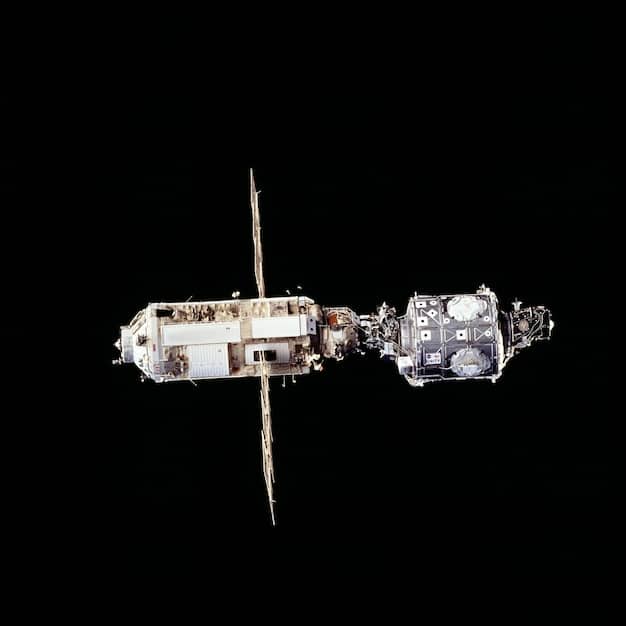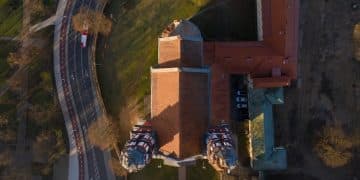US Military’s Space Defense: Preparing for Future Conflicts

The US military is enhancing its space capabilities through advanced technology, strategic defense programs, and international alliances to protect its assets and maintain dominance in the event of potential conflicts in space.
The realm of space, once perceived as a peaceful frontier for exploration and scientific advancement, is rapidly transforming into a potential arena for military conflict. The United States military, recognizing this shift, is actively enhancing its capabilities to safeguard its assets and interests in space. Discover how is the US military preparing for potential conflicts in space?
Understanding the Escalating Space Threat
The increasing reliance on space-based assets for communication, navigation, and surveillance has made them attractive targets in potential conflicts. Nations are developing anti-satellite (ASAT) weapons, posing a significant threat to critical infrastructure in orbit. It is crucial to understand the nature and scope of these threats to appreciate the US military’s preparation efforts.
The Rise of Anti-Satellite Weapons
The proliferation of ASAT weapons by various nations has heightened concerns about the vulnerability of space assets. These weapons range from ground-based missiles to co-orbital satellites capable of disabling or destroying satellites in orbit.
Cyber Warfare in Space
Cyberattacks targeting satellite systems represent another growing threat. Cyber warfare can disrupt satellite communications, compromise sensitive data, or even disable satellite functionality, causing widespread disruptions on Earth.

The US military is addressing these threats through:
- Investing in resilient satellite architectures that can withstand attacks.
- Developing advanced cyber defenses to protect satellite systems from cyber intrusions.
- Enhancing situational awareness capabilities to detect and respond to potential threats in space.
In summary, the escalating threats in space necessitate a proactive and comprehensive defense strategy. The US military is actively working to address these challenges and maintain its strategic advantage in space.
Establishing the US Space Force
In response to the growing importance of space as a military domain, the United States established the US Space Force (USSF) in December 2019. This marked a significant recognition of the need for a dedicated military branch focused on space operations and defense.
Mission and Objectives
The USSF’s primary mission is to protect US interests in space, deter aggression, and conduct space operations. It is responsible for organizing, training, and equipping space forces to ensure freedom of operation in the space domain.
Key Responsibilities
The responsibilities of the USSF include developing space doctrine, acquiring space capabilities, and conducting space-based operations. It also works closely with other military branches and government agencies to integrate space capabilities into broader national security strategies.
The US Space Force focuses on:
- Enhancing space domain awareness to detect and track potential threats.
- Developing defensive and offensive space capabilities to deter aggression.
- Collaborating with international partners to promote responsible behavior in space.
Overall, the establishment of the US Space Force is a critical step in ensuring the United States can effectively address the challenges and opportunities presented by the evolving space domain, solidifying its commitment to space security and dominance.
Advancing Space Domain Awareness
Space Domain Awareness (SDA) is crucial for identifying, tracking, and characterizing objects in space. A comprehensive SDA capability provides early warning of potential threats, enables effective space traffic management, and supports informed decision-making.
Monitoring Space Objects
The US military is investing in advanced sensors and surveillance systems to monitor objects in space, including satellites, debris, and potential threats. This includes ground-based radars, space-based telescopes, and advanced data analytics capabilities.
Predicting Space Weather
Space weather, such as solar flares and geomagnetic storms, can disrupt satellite communications and damage space-based assets. The US military is enhancing its space weather forecasting capabilities to mitigate these impacts.

Key advancements in SDA include:
- Improved tracking accuracy and identification of space objects.
- Enhanced data fusion and analysis to detect anomalies and potential threats.
- Development of predictive models to anticipate and mitigate the impacts of space weather.
In conclusion, advancing Space Domain Awareness is essential for maintaining a safe and secure space environment. The US military’s investments in SDA capabilities are vital for protecting its assets and ensuring its ability to operate effectively in space.
Developing Defensive Space Capabilities
Defensive space capabilities are designed to protect US space assets from attack or disruption. These capabilities include hardening satellites against electronic jamming, developing redundant communication systems, and deploying defensive countermeasures.
Satellite Hardening
Hardening satellites involves reinforcing their structures and systems to withstand attacks, such as electronic jamming or direct-ascent ASAT weapons. This can include shielding sensitive components, implementing redundant systems, and improving cyber defenses.
Redundant Communication Systems
Establishing redundant communication systems ensures that critical data can be transmitted even if primary communication channels are disrupted. This can involve using multiple satellite constellations, ground-based communication networks, and alternative communication methods.
The US military is also focused on:
- Developing maneuverable satellites that can evade attacks.
- Implementing advanced cyber defenses to protect against cyber intrusions.
- Improving the resilience of ground-based infrastructure supporting space operations.
In essence, developing robust defensive space capabilities is critical for ensuring the survivability of US space assets and maintaining its ability to operate effectively in the space domain. These measures are essential for deterring aggression and protecting US interests in space.
Pursuing Offensive Space Capabilities Responsibly
While defensive measures are crucial, the US military also recognizes the need for offensive space capabilities to deter aggression and protect its interests. However, the pursuit of offensive capabilities must be approached responsibly, in accordance with international law and norms.
Deterrence through Capability
Having credible offensive space capabilities can deter potential adversaries from attacking US space assets. The ability to respond effectively to aggression can dissuade others from initiating hostile actions in space.
Strategic Options
Offensive space capabilities provide strategic options for responding to aggression in space. This can include disabling or disrupting enemy space assets or conducting cyberattacks against adversary space systems.
The US military focuses on developing:
- Non-kinetic offensive capabilities, such as electronic warfare and cyber operations.
- Kinetic capabilities as a last resort, in accordance with international law and norms.
- Clear rules of engagement for the use of offensive space capabilities.
In conclusion, pursuing offensive space capabilities is a necessary component of a comprehensive space strategy. However, it is essential to approach this responsibly, in accordance with international law and norms, to ensure the long-term stability and security of the space domain.
Fostering International Cooperation
International cooperation is essential for promoting responsible behavior in space and ensuring the long-term sustainability of space activities. The US military actively collaborates with allies and partners to address shared challenges and advance common interests in space.
Sharing Information and Resources
Sharing information and resources with allies and partners enhances Space Domain Awareness and improves the ability to detect and respond to potential threats. This can include sharing tracking data, intelligence, and best practices for space operations.
Joint Exercises and Training
Conducting joint exercises and training with allies and partners improves interoperability and strengthens collective defense capabilities. This can include simulations of space-based attacks, joint satellite operations, and collaborative research and development.
Key areas of international cooperation include:
- Developing common standards and norms for responsible behavior in space.
- Establishing mechanisms for space traffic management and collision avoidance.
- Coordinating responses to space-based threats, such as cyberattacks and ASAT weapons.
In summary, fostering international cooperation is crucial for maintaining a safe, secure, and sustainable space environment. The US military’s engagement with allies and partners is essential for addressing shared challenges and advancing common interests in space, reinforcing global space security.
| Key Point | Brief Description |
|---|---|
| 🚀 US Space Force | Dedicated military branch focused on space operations and defense. |
| 🛰️ Space Domain Awareness | Monitoring space objects and predicting space weather to mitigate impacts. |
| 🛡️ Defensive Capabilities | Protecting US space assets from attacks via satellite hardening and redundancy. |
| 🤝 International Cooperation | Sharing resources and conducting joint exercises to enhance space security. |
Frequently Asked Questions
▼
The US Space Force is a military branch dedicated to protecting US interests in space, organizing, training, and equipping space forces for space operations.
▼
SDA involves monitoring and tracking objects in space to identify potential threats and manage space traffic, enabling informed decision-making.
▼
The US military protects satellites by hardening them against attacks and developing redundant communication systems to ensure resilience.
▼
Offensive space capabilities deter aggression and provide strategic options for responding to hostile actions in space, while adhering to international laws.
▼
International cooperation fosters responsible behavior in space, enhancing Space Domain Awareness and collective defense capabilities through joint exercises and information sharing.
Conclusion
In conclusion, the US military is proactively preparing for potential conflicts in space through the establishment of the US Space Force, advancements in Space Domain Awareness, development of defensive and offensive capabilities, and fostering international cooperation. These comprehensive efforts are essential for protecting US interests, deterring aggression, and ensuring the long-term security and sustainability of the space domain.





